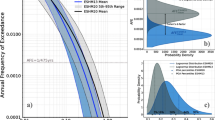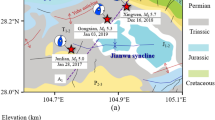Abstract
The Gujarat and adjoining region falls under all four seismic zones V, IV, III and II of the seismic zoning map of India, and is one of the most seismically prone intracontinental regions of the world. It has experienced two large earthquakes of magnitude M w 7.8 and 7.7 in 1819 and 2001, respectively and several moderate earthquakes during the past two centuries. In the present study, the probability of occurrence of earthquakes of M ≥ 5.0 has been estimated during a specified time interval for different elapsed times on the basis of observed time intervals between earthquakes using three stochastic models namely, Weibull, Gamma and Lognormal. A complete earthquake catalogue has been used covering the time interval of 1819 to 2006. The whole region has been divided into three major seismic regions (Saurashtra, Mainland Gujarat and Kachchh) on the basis of seismotectonics and geomorphology of the region. The earthquake hazard parameters have been estimated using the method of maximum likelihood. The logarithmic of likelihood function (ln L) is estimated and used to test the suitability of models in three different regions. It was found that the Weibull model fits well with the actual data in Saurashtra and Kachchh regions, whereas Lognormal model fits well in Mainland Gujarat. The mean intervals of occurrence of earthquakes are estimated as 40.455, 20.249 and 13.338 years in the Saurashtra, Mainland Gujarat and Kachchh region, respectively. The estimated cumulative probability (probability that the next earthquake will occur at a time later than some specific time from the last earthquake) for the earthquakes of M ≥ 5.0 reaches 0.9 after about 64 years from the last earthquake (1993) in Saurashtra, about 49 years from the last earthquake (1969) in Mainland Gujarat and about 29 years from the last earthquake (2006) in the Kachchh region. The conditional probability (probability that the next earthquake will occur during some specific time interval after a certain elapsed time from last earthquake) is also estimated and it reaches about 0.8 to 0.9 during the time interval of about 57 to 66 years from the last earthquake (1993) in Saurashtra region, 31 to 51 years from the last earthquake (1969) in Mainland Gujarat and about 21 to 28 years from the last earthquake (2006) in Kachchh region.
Similar content being viewed by others
Author information
Authors and Affiliations
Corresponding author
Rights and permissions
About this article
Cite this article
Yadav, R.B.S., Tripathi, J.N., Rastogi, B.K. et al. Probabilistic Assessment of Earthquake Hazard in Gujarat and Adjoining Region of India. Pure appl. geophys. 165, 1813–1833 (2008). https://doi.org/10.1007/s00024-008-0397-6
Received:
Accepted:
Published:
Issue Date:
DOI: https://doi.org/10.1007/s00024-008-0397-6




